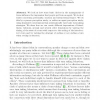Free Online Productivity Tools
i2Speak
i2Symbol
i2OCR
iTex2Img
iWeb2Print
iWeb2Shot
i2Type
iPdf2Split
iPdf2Merge
i2Bopomofo
i2Arabic
i2Style
i2Image
i2PDF
iLatex2Rtf
Sci2ools
IVA
2009
Springer
2009
Springer
Turn Management or Impression Management?
We look at how some basic choices in the management of turns influence the impression that people get from an agent. We look at scales concerning personality, emotion and interpersonal stance. We do this by a person perception study, or rather an agent perception study, using simulated conversations that systematically vary basic turn-taking strategies. We show how we can create different impressions of friendliness, rudeness, arousal and several other dimensions by varying the timing of the start of a turn with respect to the ending of the interlocutor’s turn and by varying the strategy of ending or not ending a turn when overlap is detected.
| Added | 25 Jul 2010 |
| Updated | 25 Jul 2010 |
| Type | Conference |
| Year | 2009 |
| Where | IVA |
| Authors | Mark ter Maat, Dirk Heylen |
Comments (0)

